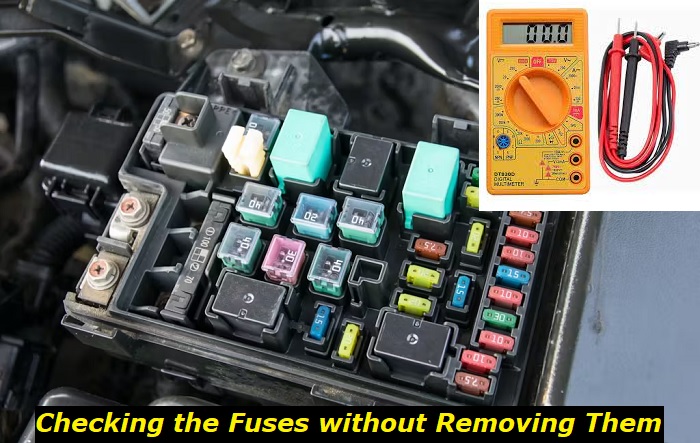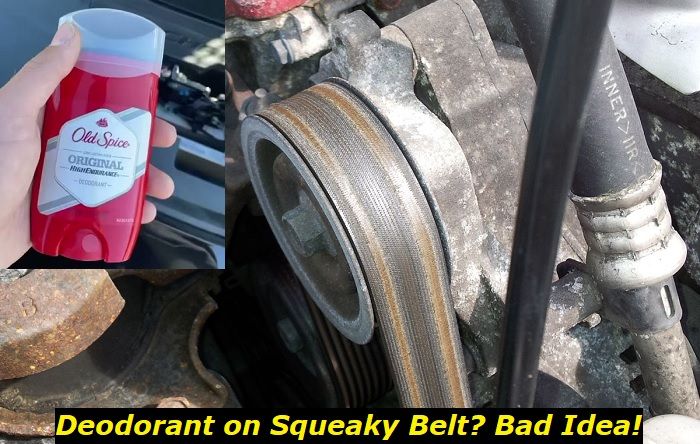Fuses are very often the culprits of the most dreadful events in your car's electrical system. When they are blown, one of the important units in your vehicle stops getting power supply. And if it's something like radio, you can live with that because the car will move on. But if it's an ignition fuse or the fuel pump fuse, you are in trouble.
I recently posted an article about fuses that can stop your car from starting - you may also want to have a look at it.
So, to check the fuses in your car without removing them, you will need one of two things: the multimeter or the test light. In this article, I will show you how exactly you should test the fuses quickly and with no additional costs.

Multimeter method - the easiest for everyone
I strongly recommend choosing the multimeter method because it's easy, clear, and safe for you and your vehicle. Of course, for this, you will need the multimeter and I hope you already have one. If you don't, please choose literally any kind of multimeter or maybe ask your friends if they can borrow you one for several hours.
Now, it's important to choose the multimeter that beeps when set to continuity and applied to a properly functioning wiring. How to do that? Set the chosen multimeter to the Continuity setting and touch the red and the black contacts. You should hear a beep. If the multimeter you chose doesn't beep, it will still be possible to check the fuses, but this will take much more time.
So, here's how you check the fuses in your car with the multimeter without removing the fuses:
1) Set the multimeter to the Continuity settings
For this, you will need to rotate the knob and choose the Continuity pictogram which resembles the Wi-Fi pictogram, in most multimeters.
2) Check if everything works
Touch the two contacts and make sure you hear the beep and see the figures on the screen changing.
3) Locate the fuses you want to check
If it's a certain fuse, you will need the fuse map for your vehicle. Otherwise, just locate all the fuse boxes in the car to get access to all important fuses. Usually, there are 2 or 3 fuse boxes but things may be much more tangled.
4) Disconnect the 12V battery.
To avoid any problems with the electrical system in your car, disconnect the battery. First, pull off the cable from the negative terminal, then disconnect the positive one.
5) Open the fuse boxes and get access to the fuses.
6) Make sure, your fuses have two little metal spots on their surfaces.
This is exactly the feature that will allow you to check the continuity inside the fuse without removing the thing.
7) Check the continuity in each fuse.
To do this, place one of the contacts of your multimeter on one metal spot of the chosen fuse and the second contact - on another metal spot on the same fuse. If the fuse is good, you will hear the multimeter beeping. Also, the numbers on the display of the multimeter will change. It doesn't matter which contact you put on which side of the fuse.
8) Check each fuse in the box
If you don't have a certain type of fuse you want to check, just quickly run through all the fuses and make sure they are all functioning.
So, this is how you check your fuses with the multimeter. If the fuse is blown, you will not hear the multimeter beeping. In this case, just replace the broken fuse. Make sure you use the same type and amps as needed in your vehicle. Usually, you can find the fuse map on one of the sides of the plastic cover on the fuse box. But sometimes, you will need to search for that map online.
The test light method of checking the fuses
The basic model of the multimeter is going to cost you about $40. But there is a cheaper version to opt for if you need to check the fuses and don't expect any other functionality from your purchase. You can buy a $10 test light for fuses. This is a circuit tester that's easy to use.
To apply the test light, you won't need to disconnect the battery. Also, you will need to do the following:
1) Connect the clip of the test light to the negative terminal.
Usually, it's pretty easy to connect it to the nut that holds that terminal cable. Alternatively, you can connect it to any unpainted metal part of the car (ground).
2) Check the light.
Touch the pin of the connector to the positive terminal and make sure that the light is working.
3) Locate the fuses you need to check.
You may want to check a certain fuse or all of them. This will not take a lot of time.
4) Touch one metal pin.
Touch the pin of your test light to one of the small metal spots on the fuse without removing it. The light should be on.
5) Touch another metal pin on the same fuse
After you check the continuity on one pin of the fuse, you may go on to check the second pin. Both should be working and lighting up the test light.
6) Check every needed fuse that way
You can continue checking other fuses.
You should make sure that both metal pins light up the test light. If one of the pins is dead and the test light doesn't go on when you touch it, it means that the fuse is blown and needs replacement.
I don't like this method because it's a little risky. Your battery is connected and it's possible that you touch something that you shouldn't touch with that test light. This may cause electrical problems and short circuits. So, if possible, use the multimeter.
What to do when you locate the blown fuse?
These tests are aimed at locating the fuse which is blown. Once you find it, it's important to stop your tests and replace the broken fuse with the proper one. For this, make sure that you have the working fuse with the needed amps. Usually, the amps are written on the fuse itself - it can be 10 amps, 15 amps, etc.
Just pull out the blown fuse, throw it away, and install the new one - as simple as that. Before installing the new fuse, you may want to check its metal legs for continuity using the multimeter. Alternatively, you can check it with the test light after you install the new fuse.
If you install the fuse with the wrong amps, it may cause some electrical problems. The little fuse will most likely be blown right away. The fuse with more amps than needed will not do its job and will most likely not protect your electrical systems from disasters.
If the fuse is blown, it basically breaks the circuit in the system, and the electrical equipment that it covers just stops working. There are intricate schemes of using fuses in modern vehicles, so you may be surprised by how unexpected the fuse map is in your car.
What if you can't check the fuses without removing them?
If for any reason you can't check the fuses with any of the methods given above, you have one good choice: take the fuse that you suspect out of the box and check it.
To avoid extra work, make sure you do the following:
- first of all, check the fuse map for your vehicle and make predictions about which fuses may not be working;
- locate these fuses in different fuse boxes in your car;
- you may want to disconnect the battery before you take the fuses out to avoid any possible issues;
- take the suspected fuse out of the box;
- visually, you almost never can say if the fuse is blown, so you will need to use the multimeter;
- set your multimeter to continuity measuring;
- put multimeter connectors to both legs of the fuse - it doesn't matter which color goes to which leg;
- make sure the multimeter beeps and/or shows some changed figures on the screen.
If your multimeter shows some continuity between the two legs of the fuse, you can say for sure that the fuse is functioning well. If you don't get the multimeter beeping when you touch the legs of the fuse with the multimeter contacts, the fuse is blown and needs to be changed.
Can you drive with a blown fuse?
The depends on the fuse that is blown. If it's something like a radio or dashboard lighting, you may keep driving. The car will not function as it should and some features will not be available but the car will be drivable.
If some important fuse is broken like the fuel pump fuse or the electric power steering fuse, there is no chance you can still drive the vehicle. In most cases, you will need to get the new fuse or call the tow truck to get your vehicle towed to the place where you can buy and replace the fuse.
About the authors
The CarAraC research team is composed of seasoned auto mechanics and automotive industry professionals, including individuals with advanced degrees and certifications in their field. Our team members boast prestigious credentials, reflecting their extensive knowledge and skills. These qualifications include: IMI: Institute of the Motor Industry, ASE-Certified Master Automobile Technicians; Coventry University, Graduate of MA in Automotive Journalism; Politecnico di Torino, Italy, MS Automotive Engineering; Ss. Cyril and Methodius University in Skopje, Mechanical University in Skopje; TOC Automotive College; DHA Suffa University, Department of Mechanical Engineering






Add comment